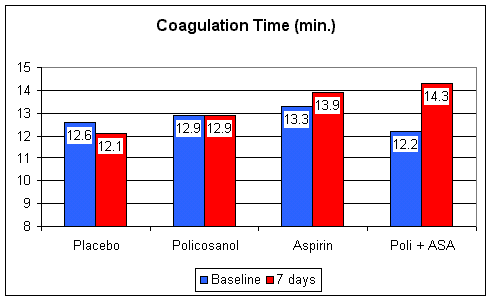
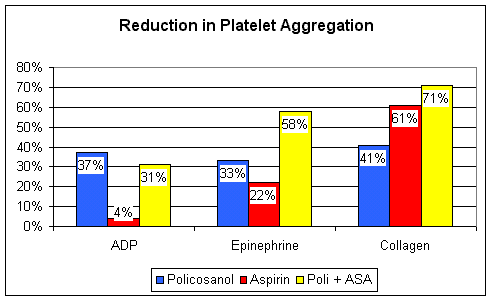
Return to Medical Topics Home Page
POLICOSANOL
1. Policosanol is superior to, and synergistic with Aspirin as an anti-platelet agent
2. Policosanol lessens claudication and improves outcome in the vascular patient
1. Comparative Study of Policosanol, Aspirin, and the Combination Therapy Policosanol-Aspirin on Platelet Aggregation in Healthy Volunteers. Arruzazabala, m, et al. Pharmacological Research, Vol. 36, No. 4, 1997.
Atherosclerotic plaque formation within your arteries does not cause heart attack and stroke. Rather, these dreadful events occur when a blood clot (termed thrombus) forms up over a region "vulnerable plaque" which has "cracked" or "ruptured". The first step in blood clot formation is aggregation of blood platelets, the initial forces or "marines" of the coagulation army, at the site of vascular wall damage. Anti-platelet therapies, such as Aspirin, which interfere with platelet aggregation, are thus useful in the primary and secondary prevention of heart attack and stroke. We touched on the phenomena of platelet function, and how it is controlled, in section 14 of the Vitamin C tip of the month. Conditions or treatments that improve endothelial function, which improve nitric oxide formation, will inhibit platelet stickiness, while conditions which impair endothelial nitric oxide production, such as smoking, diabetes, homocysteine, or as discussed in the Vitamin C section, long-acting NTG preparation, impair not only endothelial function but also heighten platelet stickiness - a double clot forming whammy.
When evaluating a patient with recurrent or inoperable coronary disease, one of the first tests I order is an assessment of platelet aggregation. A blood sample is taken and forwarded to Amscott Labs in Cincinnati. The platelets are isolated, and then exposed to agents known to precipitate platelet aggregation in the test tube situation (in vitro) and within your circulation (in vivo) - please see table below. Even though nearly all of my new patients are on aspirin, abnormal platelet aggregation is the rule; the only time I see normal platelet function is when the patient is also on an appropriate regimen of nutritional substances (like antioxidants and fish oil). A goal of our treatment is to normalize any abnormality in platelet function that may be present, without placing you at risk for abnormal bleeding. In standard cardiology we can inhibit platelet aggregation with drugs like Plavix®, which costs $3 a day, or we can spend $1000 and give you a single dose of IV antibodies directed against your platelets; this sure inhibits platelet aggregation, but sometimes we overshoot the mark and cause an abnormal platelet deficiency state. These drug approaches do work; they lessen your risk of clot formation and do improve your outcome, and they are an appropriate mainstay of therapy to prevent vessel re-closure after stent implantation, but a better approach, at least to my way of thinking, is for us to normalize your platelet function with low-cost nutritional agents.
|
Aggregating agent |
Physiological Correlations |
| ADP - Adenosine Diphosphate | ADP levels rise when energy production falls of due to insufficient oxygen supply |
| Collagen | Exposed to platelets when a vulnerable plaque cracks |
| Epinephrine - Adrenaline | Levels rise in response to cardiovascular stress states |
In this study, Dr. Arruzazabala and his associates studied the effects of Policosanol, Aspirin, and Policosanol-Aspirin co-treatment on platelet aggregation in normal individuals. Baseline platelet aggregation and skin bleeding time measurements were made in 43 healthy volunteers, who were then assigned, at random, to a 7-day program of:
A) Policosanol 20 mg/day, B) Aspirin 100 mg/day, C) Policosanol 20 mg and Aspirin 100 mg/day, or D) Placebo
Platelet function and bleeding time measurements were repeated at 7 days; the results are presented below. The study was double-blind; that is neither the subjects nor the researchers knew which regimen each subject was taking.


1st lets look at bleeding time, a measure of safety. Here we make a shallow, one cm. nick in your skin with a scalpel and measure how long it takes for the bleeding to stop (I had to do carry out this test when I was in intern - it's tedious and the patients didn't like it when I brought out the scalpel). You can see that neither placebo or Policosanol had any significant effect on the bleeding time. Aspirin prolonged the bleeding time by 36 seconds, while the combination of Aspirin and Policosanol prolonged the bleeding by just over two minutes. Now, a 2-second increase in bleeding time isn't going to cause serious side-effects; rather this is why those of you on aspirin, Plavix, or here Aspirin0Policosanol combination therapy might note a tendency to bleed a little longer if you cut yourself shaving. The point here is that Policosanol is safe, even when combined with Aspirin.
2nd, lets look at therapeutic efficacy. ADP is released when cells are starved of oxygen such that they cannot produce energy packets, ATP, from ADP - this occurs whenever you experience angina or claudication. ADP increases the tendency of platelets to form a clot and we want to blunt this. You can see that Aspirin had only a negligible effect, decreasing platelet aggregation only 4% from baseline, while Policosanol led to a 37% reduction. Combination Policosanol-Aspirin had no additive effect on this measure of platelet function. Epinephrine, also known as Adrenaline, is our primary cardiovascular stress hormone. Epinephrine levels are high when ever cardiovascular stress is experienced. Epinephrine and the cardiovascular patient's exaggerated response to Epinephrine underlie heart attack and sudden death, when a cardiac patient is exposed to severe stress. Policosanol again beat out Aspirin, 33% to 22%, but of note, combination therapy provided the best response, blunting platelet aggregation by 58%. When you artery cracks, collagen, the structural protein that provides structure and toughness to your artery, is exposed to the circulation. This is an abnormal situation; your body recognizes this as a "leak in the dike" and attempts to repair it. The first step is platelet aggregation stimulated by the exposure of platelets to collagen*. This is great if you gash your skin running away from a saber tooth tiger, but it's not so great when the wall of your diseased coronary artery cracks and you "repair" it with a blood clot that ends your life. Aspirin was superior to Policosanol in this measure of platelet aggregation, but of note, the combination of Aspirin and Policosanol provided the best protection.
Arruzazabale has demonstrated that Policosanol is superior to Aspirin as an inhibitor of platelet aggregation. With respect to this parameter, if you had to pick one or the other, Policosanol would be your choice. Of course, you don't have to pick one over the other. You don't have to take only Aspirin alone (orthodox recommendation), or Policosanol alone (alternative medicine recommendation); you can take both (lets use our minds and help our patients recommendation). At this point in our discussion a critic might point out that Aspirin has been shown to decrease event rates, and Policosanol has not; regarding this important point please read on.
Policosanol blunts Platelet Aggregation better than does Aspirin
*while platelet aggregation, to initiate a blood clot, is the first wave of the vascular wall rent repair process, a 2nd wave in the attachment of LDL cholesterol bearing Lipoprotein(a) to the damaged vascular wall. Lp(a) also binds to the exposed collagen, as we discussed in section 9 of the Vitamin C tip of the month.
2. A Long-Term Study of Policosanol in the Treatment of Intermittent Claudication. Castano, G, it al. Angiology Vol. 52, No. 2, 2001, pp. 115125.
OK, so we've demonstrated that treatment with Policosanol leads to beneficial effects on lipids, blood pressure, and platelet aggregation, but just what effect will Policosanol have on symptoms (and outcome) in patients with established cardiovascular disease. Anti-platelet therapy with drugs such as Trental® and Pletal® decrease symptoms and increase walking time in patients with impaired lower extremity blood flow. Policosanol inhibits platelet aggregation, so let's see if Policosanol can help patients with claudication.
Castano studied the effects of Policosanol in a group or 56 patients with impaired lower extremity blood flow and stable claudication (calf cramping due to inadequate blood flow to the leg muscles during exercise). Pre-study, all subjects were experiencing leg pain (ICD - initial claudication distance) between 50 and 300 meters, while walking on a treadmill at 3.2 km/hr at 10% grade, with a maximum walking distance (ACD - absolute claudication distance) of < 500 meters. All subjects had an abnormal ABR (Ankle-Brachial Ratio: BP in the arm - BP at the ankle divided by the arm BP; a value below one reflects impaired lower extremity blood flow). 45% of the subjects had concomitant coronary disease, 75% were hyperlipidemic and 65% smoked during the study.
After the baseline assessment was completed, the subjects were assigned, at random, to receive Policosanol at a dose of 10 mg twice a day, or a matching placebo. Dietary modification and smoking cessation were advised, but none of the subjects participated in a structured exercise program. Treadmill and ABR measurements were repeated at 6, 12, 18, and 24 months. The researchers also recorded treatment related side-effects and any adverse cardiovascular events that occurred over the 24-month study period. The study was double-blind; neither the investigators nor the subjects knew who was receiving Policosanol or placebo. So what effect, if any, did Policosanol have on the patients symptoms and vascular status?
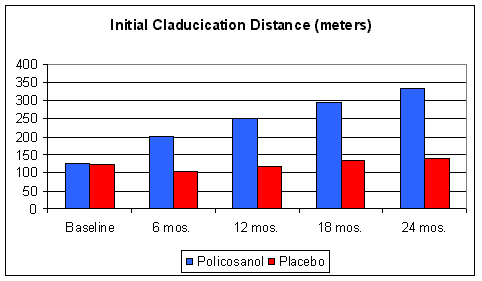

Pain-free walking distance (Initial Claudication Distance) did not change significantly in the placebo group (as expected), while the patients assigned to Policosanol experienced a 60% increase at 6 months. The Policosanol effect did not wear off, but improved further with continued treatment. At 24 months, ICD had increased by 207 meters, nearly triple the baseline value. The same relationship held for Absolute Claudication Distance; placebo treatment had no effect while Policosanol tripled the subjects' maximal walking distance.

Now lets look at the Ankle-Brachial-Ratio findings. We know that Policosanol has significant anti-platelet, anti-oxidant, and endothelial friendly effects, but can Policosanol actually increase blood flow to the legs?
The answer appears to be: YES! The ABR value increased negligibly in the placebo group, from .61 to .64, but increased a statistically significant 20% with Policosanol supplementation, from .59 to .71
The table below lists of percentage of subjects in each group that noted an improvement in their vascular symptoms of leg tingling, coldness, and pain. Here again, placebo had little effect, while a reduction in each symptoms was noted in 3/4ths of the Policosanol treated subjects.
| 6 months | 12 months | 18 months | 24 months | |
|
Leg Tingling Improved |
||||
| Policosanol | 63% | 74% | 70% | 78% |
| Placebo | 10% | 0% | 14% | 10% |
|
Leg Coldness Lessened |
||||
| Policosanol | 63% | 78% | 74% | 78% |
| Placebo | 31% | 3% | 14% | 10% |
|
Leg Pain Improved |
||||
| Policosanol | 70% | 67% | 74% | 78% |
| Placebo | 14% | 7% | 17% | 10% |
What about safety and patient tolerance? Did any of the subjects have to drop out of the study due to side-effects? Were there any adverse outcomes? These are important issues. A well known cholesterol drug was shown in a "landmark study" to decrease 4-year heart attack and cardiac death rates. These "results" were widely publicized, to physicians and patients alike, but when I actually read the paper, I learned that overall mortality was unaffected by the cholesterol lowering drug. Fewer people were dying of heart disease, but just as many people were dying. It turned out that rates of suicide and violent death were greater in the drug treatment group. The authors didn't make a big deal over this issue and the drug reps did not bring it to my attention, or yours, and the drug is a big seller. We know that Policosanol has cholesterol lowering effects and it certainly appears to have a beneficial effect on lower extremity blood flow - Now let's make sure that it is not going to harm us in other ways.
Not to worry about Policosanol, but perhaps being in the placebo group was not such a good idea. 4 Policosanol subjects withdrew from the study, all for administrative reasons. 3 reported minor, non-cardiac related symptoms. 12 placebo subjects withdrew, 3 for administrative reasons, 1 due to lack of improvement, and 8 due to adverse events. No Policosanol subject experienced an adverse event during the 2-year treatment period, while 8 placebo subjects experienced a total of 10 adverse events (2 deaths, 1 due to stroke and 1 due to respiratory failure, 2 heart attacks, 2 TIAs, 1 unstable angina, 1 non-fatal stroke, 1 surgery, and 1 hypertensive emergency).
In the placebo subjects we are seeing the natural 2-year history of patients with vascular disease and risk factors; it isn't very good. The Policosanol subjects did better; they had fewer heart attacks and strokes, and you have figured out why. Policosanol wasn't just improving lower extremity blood flow, Policosanol was improving blood flow everywhere. The Policosanol treated patients could walk 3 times farther, their ABR values improved, they did better overall, and the treatment was well tolerated. Speaking of blood flow to the brain....
Policosanol lessens claudication and improves patient outcome
3. Functional Improvement in Coronary Artery Disease After 20 Months of Lipid-Lowering Therapy With Policosanol. Batista, J, et al. Advances In Therapy Vol. 13, No. 3, May/June 1996.
OK, so Policosanol improves blood flow to the legs and the brain. I'm a heart doctor and you are heart patients; we want to know what Policosanol is going to do for the patient with coronary insufficiency. To find out, Dr. Batista and his associates carried out a randomized, placebo-controlled, double-blind study of Policosanol, with or without aspirin, looking at lipid values, stress test parameters, and Thallium scan findings in 45 patients with well-documented coronary artery disease.
41 of the 45 subjects were hypercholesterolemic and 41 had sustained a prior heart attack; 2/3rds were smokers. Stress thallium scans demonstrated ischemia in all subjects, indicating the presence of viable heart muscle, jeopardized by a coronary artery blockage (the stress Thallium scan and the relationship between an improvement in Thallium scan findings and patient outcome is discussed in several of the articles abstracted in the EECP LITERATURE REVIEW section).
All 45 subjects initially underwent a 4-week program of dietary and lifestyle counseling. All subjects received advice regarding smoking cessation, stress reduction, and a low-fat, low-calorie diet. The subjects were then assigned in random fashion to receive, over 20 months: a) Policosanol 5 mg twice a day, b) Policosanol 5 mg and Aspirin 125 mg, both twice a day, or c) Aspirin 125 mg and placebo, both twice a day. Given the known benefits on anti-platelet therapy in coronary disease patients, the researchers did not feel that the inclusion of a placebo alone group would be ethical; thus Policosanol was compared against Aspirin. Neither the researchers nor the subjects knew which regimen an individual subject was taking.
Multiple measures of cardiovascular function were recorded at baseline and periodically throughout the 20-month study (the baseline to 20-month comparisons are shown and discussed below). 4 subjects dropped out after the 1st six months, all for administrative reasons. Outcomes for the 41 subjects who completed the 20-month study are presented in chart form and discussed below. First let's look at changes in lipid values:
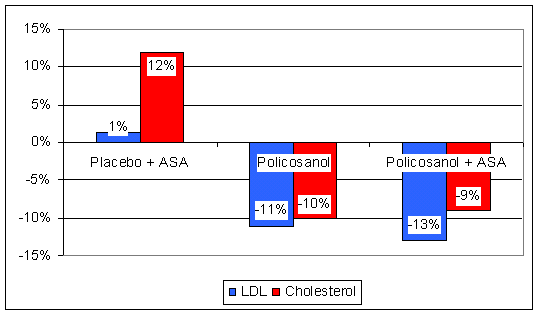
Cholesterol rose by 12% in the placebo plus Aspirin group. Total and LDL Cholesterol fell by around 10% in both Policosanol groups, not a surprise to you at this point.
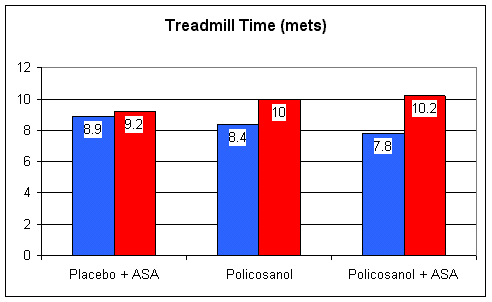
On
these charts, blue is baseline and red represents the 20 month values.
METs (Maximal Exercise Tolerance units) is a measure of exercise capacity, and
correlates with how long you can walk on the treadmill. You can see that
at 20 months, exercise capacity increased only negligibly in the Placebo plus
Aspirin group, while the subjects assigned to Policosanol demonstrated a 19%
increase. Policosanol plus Aspirin therapy led to a 30% increase (not
statistically different from Policosanol alone). ST segment depression on the
exercise EKG represents a supply to demand mismatch. Blood flow through
the narrowed artery is not sufficient to meet the needs of the exercising heart
muscle; energy metabolism ceases and this is reflected in the EKG as ST
depression. With EECP, as with stent placement, Policosanol, or any other
therapy, one of our goals is to increase exercise capacity and resolve or delay
the appearance of ST depression. Typically, if treadmill time (demand) is
increased in a patient with
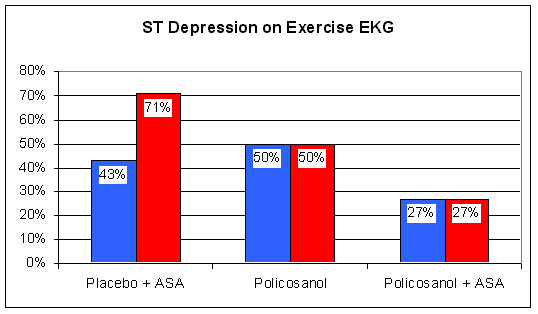 coronary
disease (fixed supply), we will see more ST depression. Here, even though
treadmill time had increased in the Policosanol and Policosanol plus Aspirin
groups, the percentage of subjects demonstrating ST depression did not increase
- this is a positive findings. On the other hand, while treadmill time did
not increase significantly at 20 months in the placebo and Aspirin groups, the
percentage of patients demonstrating ST depression did increase - these subjects
were getting worse (the natural history of coronary disease) on Aspirin monotherapy. So
from the perspective of the stress EKG, Policosanol, with or without Aspirin,
does a lot more for you than Aspirin therapy alone! That's nice, but what
will happen to the Thallium scan?
coronary
disease (fixed supply), we will see more ST depression. Here, even though
treadmill time had increased in the Policosanol and Policosanol plus Aspirin
groups, the percentage of subjects demonstrating ST depression did not increase
- this is a positive findings. On the other hand, while treadmill time did
not increase significantly at 20 months in the placebo and Aspirin groups, the
percentage of patients demonstrating ST depression did increase - these subjects
were getting worse (the natural history of coronary disease) on Aspirin monotherapy. So
from the perspective of the stress EKG, Policosanol, with or without Aspirin,
does a lot more for you than Aspirin therapy alone! That's nice, but what
will happen to the Thallium scan?

The chart on the left shows that at 20 months, the stress Thallium had worsened in 64% of the subjects assigned to placebo and Aspirin. They weren't walking farther, and blood flow had decreased; thus their Thallium scans had worsened. This is the natural history of coronary disease, to get worse, and here Aspirin alone was not helpful. Conversely, the Policosanol alone and Policosanol plus Aspirin groups were doing better; they were walking farther and a much greater percentage demonstrated an improved Thallium scan. If the scan improves after angioplasty or EECP, we pat ourselves on the back. These patients improved their scans with Policosanol alone.
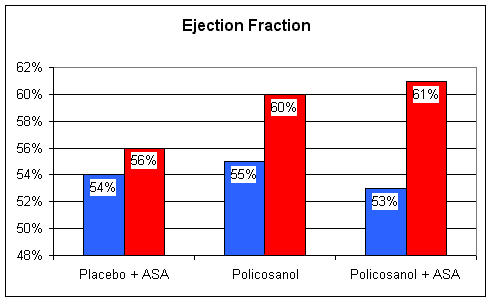 Ejection
fraction (EF) refers to the percentage of blood cells that the heart ejects with
each beat. If the heart fills with 100 cc of blood, and ejects 50 cc with
each beat, then the ejection fraction is 50%, a normal value. As a result
of our treatments, we want to see a rise in EF, and this is what we see
with Policosanol and Policosanol plus Aspirin. Aspirin alone had only a
negligible effect. When blood flow improves, the heart can beat with
greater vigor, and thus the EF rises. OK, so all these objective markers
of cardiac function improve with Policosanol, important to me as a
cardiologist. You are probably more interested on what effect Policosanol,
or any other treatment for that matter, will have on your symptom level and
outcome.
Ejection
fraction (EF) refers to the percentage of blood cells that the heart ejects with
each beat. If the heart fills with 100 cc of blood, and ejects 50 cc with
each beat, then the ejection fraction is 50%, a normal value. As a result
of our treatments, we want to see a rise in EF, and this is what we see
with Policosanol and Policosanol plus Aspirin. Aspirin alone had only a
negligible effect. When blood flow improves, the heart can beat with
greater vigor, and thus the EF rises. OK, so all these objective markers
of cardiac function improve with Policosanol, important to me as a
cardiologist. You are probably more interested on what effect Policosanol,
or any other treatment for that matter, will have on your symptom level and
outcome.
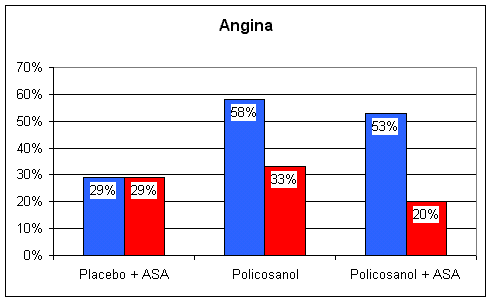

While the subjects were randomly assigned to the different treatment groups, just by chance the subjects assigned to receive Placebo plus Aspirin were less symptomatic at baseline. 29% were experiencing angina at baseline and 29% were experiencing angina at 20 months. A far greater percentage of Policosanol and Policosanol plus Aspirin patients were experiencing angina at baseline, with an obvious improvement at 20 months. Functional Class reflects how much you can do before limiting symptoms develop. Class IV patients have rest angina. Rest angina patients cannot exercise and therefore were not included in this study. At baseline, 86% of the placebo and Aspirin patients were in Class I (angina only with vigorous effort). Only 14% were in Class II (angina within blocks or two flights of stairs) or in Class III (angina at greater than two blocks or two flights). 1/3rd of the subjects assigned to one of the Policosanol groups were in Class II or III at baseline, but at 20 months nearly all had improved into Class I. Aspirin monotherapy didn't reduce angina or improve functional class, but Policosanol sure did. What about side-effect and event rates?
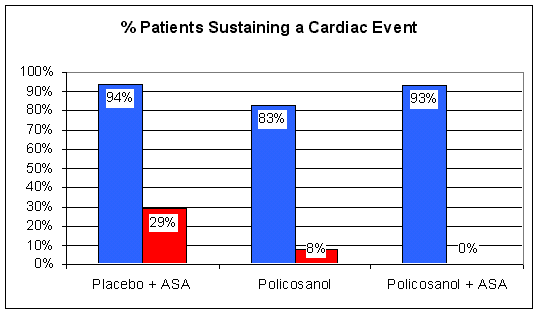 All three
regimens were well tolerated; no subject dropped out due to a treatment related
side-effect. 94% of the placebo and Aspirin subjects had experienced a
heart attack prior to enrolling in this study, as had 83% of the Policosanol and
93% of the Policosanol plus Aspirin subjects. During the 20-month study
period, 2 Aspirin alone subjects went into heart failure, one experienced unstable
angina, and one died due to a 2nd heart attack, for an overall 20-month event
rate of 29%. One Policosanol only patient sustained a non-fatal heart attack,
while the subjects assigned to Policosanol plus Aspirin remained event
free.
All three
regimens were well tolerated; no subject dropped out due to a treatment related
side-effect. 94% of the placebo and Aspirin subjects had experienced a
heart attack prior to enrolling in this study, as had 83% of the Policosanol and
93% of the Policosanol plus Aspirin subjects. During the 20-month study
period, 2 Aspirin alone subjects went into heart failure, one experienced unstable
angina, and one died due to a 2nd heart attack, for an overall 20-month event
rate of 29%. One Policosanol only patient sustained a non-fatal heart attack,
while the subjects assigned to Policosanol plus Aspirin remained event
free.
Aspirin inhibits platelet aggregation and has a definite role in the treatment of cardiovascular disease, but Aspirin alone does not lower cholesterol, improve treadmill time, ejection fraction, ST depression, or Thallium scan findings, and Aspirin alone does not decrease symptoms; rather these parameters do not change or deteriorate with Aspirin alone. In contrast, all of these subjective and objective measures of cardiovascular health improved on Policosanol. Aspirin does add to the anti-platelet aggregation effects of Policosanol, but in this study, Policosanol alone worked just as well as did Policosanol plus Aspirin.* Policosanol costs my own patients just $7.50 per month. Unless they are already on a treatment program that provides Policosanol-like effects, I can't think of a good reason not to put all of my cardiovascular patients on this agent.
Policosanol provides impressive subjective and objective benefits to the coronary patient
4. Effects of Policosanol and Pravastatin on Lipid Profile, Platelet Aggregation and Endothelemia in Older Hypercholesterolemic Patients. Castano, G, et al. Int. J. Clin. Pharm. Res. XIX(4) 105-116 (1999).
The Statin cholesterol lowering agents are wonderful drugs. They lower your cholesterol dramatically, and they provide a vascular wall antioxidant effect. Endothelial function improves, and so does patient outcome (Remember Roberts' Dictum: As goes the endothelium, so goes the patient). Statins save lives; there's no question about it. On the other hand, statins deplete Co-Enzyme Q, they do effect your EEG, they may cost up to $100 per month, and nuisance side-effects are frequent. Muscle aching is common, liver chemistries may rise, and I've yet to have a male patient tell me that his love life improved while he was on statin therapy; often it's just the opposite.
Statin drugs are great; I've been prescribing them since I began cardiology practice 16 years ago*, and I am going to continue to prescribe them, but it kind of bothers me that the drug companies are presenting statin drug therapy to you and to health care providers like me as the be all and end all of cardiac care. You get the impression that if you take this pill that "everything is going to be all right". It won't, because an elevated cholesterol is just one of the many causes of cardiovascular disease, and to prevent heart disease effectively we need to think effectively about all of its causes. Statins alone will not get the job done. We're spending a lot of money on statin therapy, and ignoring low-cost nutritional agents like Vitamin C (Vitamin C decreases 10-year death rate by 43% for pennies a day), and we're obviously ignoring the concepts of diet, exercise, and stress reduction. Medicare may soon offer a prescription drug benefit. When this occurs, we will immediately put every senior on a statin, but we won't put every senior on Vitamin C (they have to pay for this out-of-pocket, while the government pays for statin drugs). I don't think that our health care delivery system will do well in this Drugs for Everyone but Nutritionals for No One future.
Well, time for me to get off the soap box and get back to science. Many people cannot afford statin therapy, and many others cannot tolerate the side-effects of statin therapy. It would sure be nice if a low cost, well tolerated nutritional like Policosanol would work as well, or nearly as well, as a statin - then people who could not afford $100 per month for the rest of their lives would have an alternative. Cuba cannot afford to use of statin drugs in their medical system; the Cuban health system is basically limited to commodities that can be produced in Cuba. Policosanol was developed in Cuba as a low cost approach to cholesterol reduction and to cardiovascular disease in general. The following two studies directly compare Policosanol with two of the statin agents that we use in the US.
In the first study, Castano and colleagues compared Policosanol directly against Pravachol®, a prescription statin agent. 68 high-risk, hyperlipidemic subjects with additional risk factors were randomized to receive, over a 8 week period, 10 mg/day of either Pravachol® or Policosanol. All subjects were placed on the same cholesterol lowering diet, and any treatments with anti-platelet or lipid-reducing effects were discontinued 6 weeks before the baseline labs were obtained. A double-blind format was followed, such that neither the subjects nor the researchers knew which agent an individual subject was taking.
Lipid values, platelet aggregation, and counts of shed endothelial cells were recorded at baseline and following 8 weeks of treatment. The study was carried out in "typical cardiac patients" - all were hyperlipidemic, 53% had a family history of heart disease, 60% were hypertensive, 24% had known coronary disease and 58% had known lower extremity vascular disease. 18% were diabetic and 93% were taking at least one additional prescription medication. Let's see what affect Policosanol had on these multi-risk factor subjects, and how it compares with Pravachol®. Lipid lowering data is given in the table below.
| Lipids | Treatment | Baseline | 8 weeks | % change |
| Cholesterol | Policosanol | 247 | 211 | -14% |
| Pravachol | 238 | 210 | -12% | |
| LDL | Policosanol | 179 | 144 | -19% |
| Pravachol | 173 | 146 | -16% | |
| HDL | Policosanol | 39 | 43 | +18% |
| Pravachol | 39 | 40 | +6% | |
| Triglycerides | Policosanol | 177 | 148 | -14% |
| Pravachol | 157 | 152 | -3% |
With respect to total cholesterol and LDL-cholesterol values, Policosanol and Pravachol® had similar effects. However, Policosanol had superior HDL increasing and triglyceride lowering effects - here we have to give a slight edge to Policosanol. Now let's look at platelet aggregation:
| Plt. Aggreg. | Treatment | Baseline | 8 weeks | % change |
| Arachidonic
Acid |
Policosanol | 51 | 30 | -42% |
| Pravachol | 51 | 45 | -7% | |
| Collagen | Policosanol | 40 | 32 | -17% |
| Pravachol | 41 | 51 | +24% | |
| ADP | Policosanol | 33 | 24 | -20% |
| Pravachol | 28 | 27 | - |
Arachidonic Acid is a pro-inflammatory, platelet aggregating "prostaglandin" substance that we manufacture from meat and dairy fat - Arachidonic Acid is essentially the evil first cousin of fish oil. Pravachol had little effect here, while Policosanol blunted Arachidonic Acid induced platelet aggregation by 42% (better take some before lunch). Platelets are exposed to Collagen when the vascular wall is damaged; Pravachol and Policosanol did about the same here. ADP is released when energy metabolism shuts down due to inadequate oxygen supply; ADP is released, and attempts to aggregate platelets into a blood clot, whenever you experience angina. Pravachol can't help you here, but Policosanol blunted ADP-induced platelet aggregation by 20% - Policosanol does a better job with HDL and Triglycerides, and Policosanol does a better job with platelet aggregation.
Always remember Roberts' dictum: As goes the endothelium, so goes the patient! Endothelial function refers to the ability of the endothelial cells, the cells that line our arteries, to convert dietary Arginine into the vasodilating, anti-platelet aggregation vasochemical Nitric Oxide. It is the Nitric Oxide that provides the "Teflon Coating" to the artery wall. Now, when individuals with atherosclerosis exercise, dead endothelial cells are shed from the artery wall into the circulation. This is termed endothelemia. Endothelemia is a bad thing, a very bad thing, and reflects impaired endothelial health. We know that Pravachol, a statin lipid-lowering agent, has an endothelial tonic effect, so we can predict that Pravachol might blunt endothelial cell shedding - will Policosanol have the same effect? Let's see:
| Endothelemia | Baseline | 8 weeks | % change |
| Policosanol | 558 | 401 | -28% |
| Pravachol | 556 | 462 | -17% |
Policosanol wins again!
What about side-effects and patient tolerance? A rise in liver chemistries or "transaminases" is a not infrequent side-effect of statin lipid-lowering drugs. AST, a liver transaminase, rose on average from 25.5 to 26.3 in the Pravachol subjects, and fell from 24.9 to 22.3 with Policosanol; neither of these changes were statistically significant or clinically meaningful (another study showed that Policosanol was well tolerated in subjects who had demonstrated a significant rise in liver chemistries when previously on a statin). Neither agent had a deleterious effect on body weight, BP, blood sugar, or kidney function. Two Pravachol subjects discontinued the study early due to a serious adverse effect/event (one jaundice and one heart attack). Three other Pravachol subjects reported mild adverse effects (headache, muscle aching, and excessive hunger). No adverse events or side-effects were experienced by the Policosanol subjects.
a) Lipid values b) Platelet aggregation to c) Endothelial cell counts